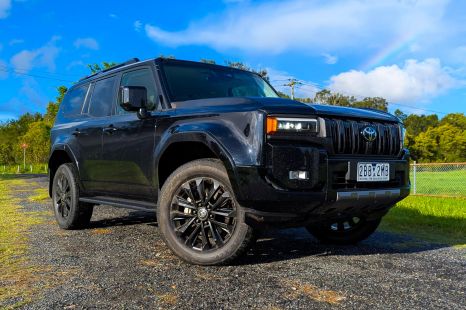

William Stopford
3 Months Ago
Japan's Range Rover is not really bigger than before, but it's certainly better. Few luxury SUVs can match its all-round abilities.
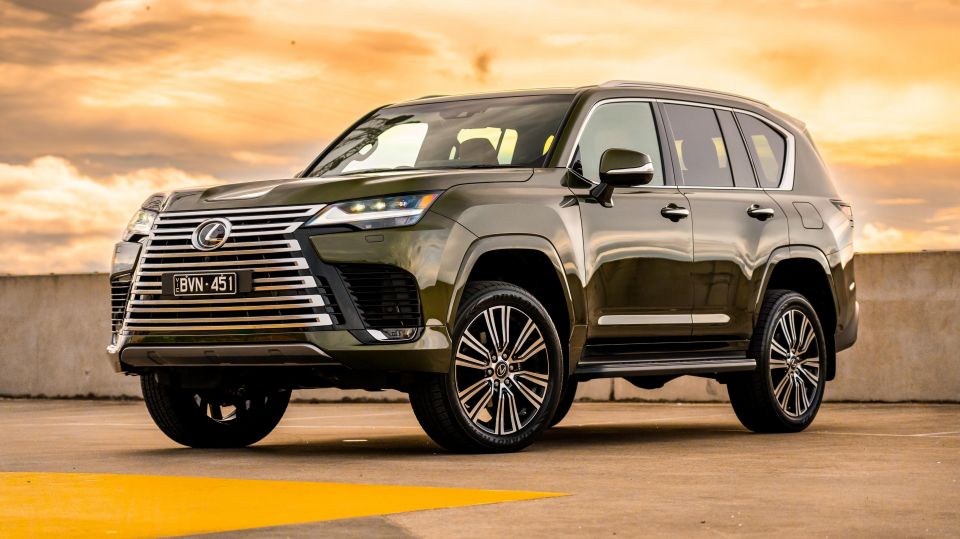
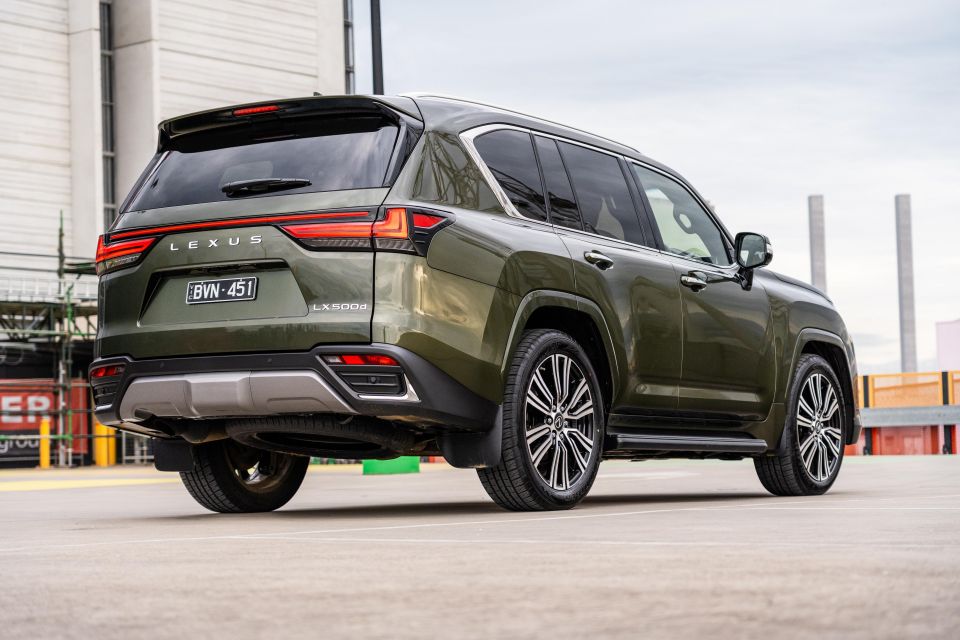

Quickly see how this car stacks up against its competition. Select any benchmark to see more details.
Take advantage of Australia's BIGGEST new car website to find a great deal on a Lexus LX.
Is the Lexus LX a glorified Toyota LandCruiser or a Japanese Range Rover? Why, both of course.
It’s also one of Australia’s most imposing and all-round capable luxury 4x4s, as comfortable on the mean streets of Toorak and Vaucluse, as it is traversing this wide brown land of ours.
That latter point is not an attribute that comes so readily to mind with more road-focused rivals such as the Mercedes-Benz GLS, BMW X7 or Audi Q8.
The formula for the LX’s creation remains the same as ever, but next to the old model it represents an overdue generational change, with next to nothing carried over.

A new body-on-frame platform, new downsized petrol and diesel engines with six cylinders rather than eight, substantially more interior tech, and height-adjustable suspension feature. So too does a front grille that is more reflective of a diesel locomotive than a car.
Yet in Khaki Metal Green with optional 22-inch wheels, few vehicles this side of an American full-size pickup are more imposing, or turn more heads. And few promise to tow a luxury caravan, thoroughbred float, or bowrider boat with such panache.
On the subject of locomotives, there’s quite the hype train underway too. The new LX only hit the market in April, yet the customer wait list already stretches beyond 12 months – such is the combination of strong demand and shorter-than-ideal supply.
Let’s walk you through it.
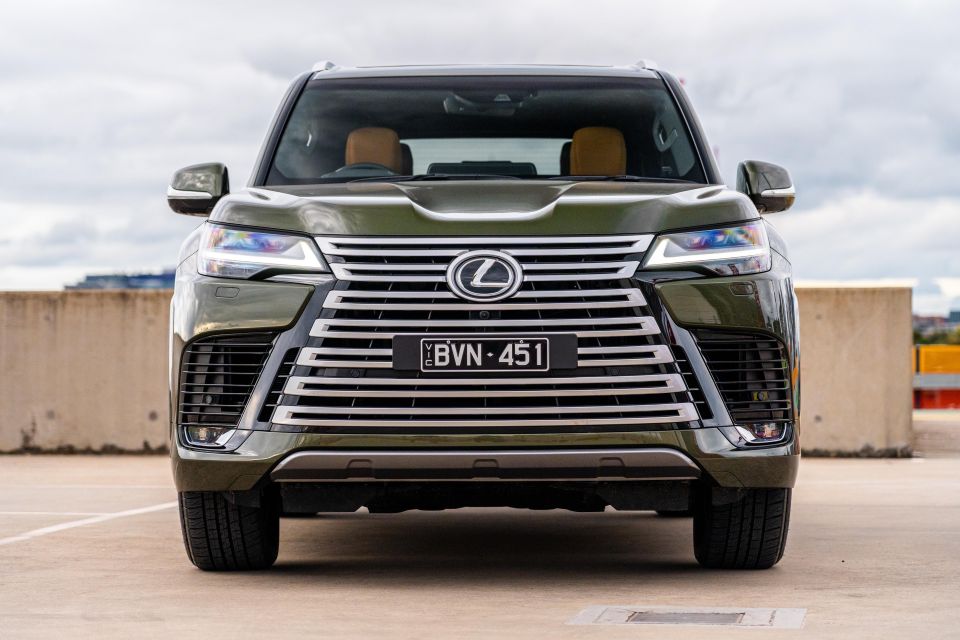
With a starting price of $148,800 before on-road costs, the Lexus’s entry point is a reasonable enough $10,000 greater than the flagship LandCruiser Sahara ZX using the same engine, reviewed here.
A $5500 Enhancement Pack for the base grade adds 22-inch alloy wheels, a sunroof, and a hands-free tailgate with kick sensor, and is fitted here.
The version we’re driving here is said base model, bolded below.
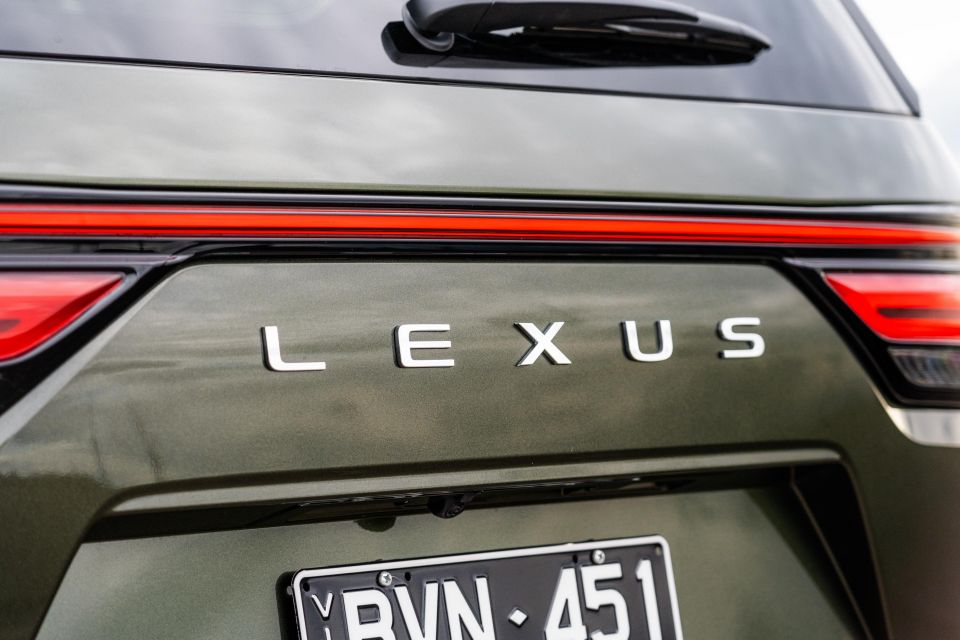
2022 Lexus LX pricing:
All prices exclude on-road costs.

The Lexus LX’s interior is not just a rebadged version of the LandCruiser’s, although it still looks very different from anything German. The company has gone to some lengths to add differentiation: in terms of materials and trims, as well as displays.
Our test car matched its dark green paint with tan-coloured, good-quality leather on the seats, door handles and armrests, and along the lower portions of the dash. The seats aren’t overly bolstered, but they’re plush and offer extensive (powered) adjustments.
Once you’ve closed the door with a reassuring thunk, you’re presented with a bespoke power-adjustable wheel with wood grain and leather, and nicely damped flush buttons that are less fiddly to operate than those in the smaller Lexus NX.
There are also numerous colour themes available for the interior light piping, which changes the night-time ambience greatly.
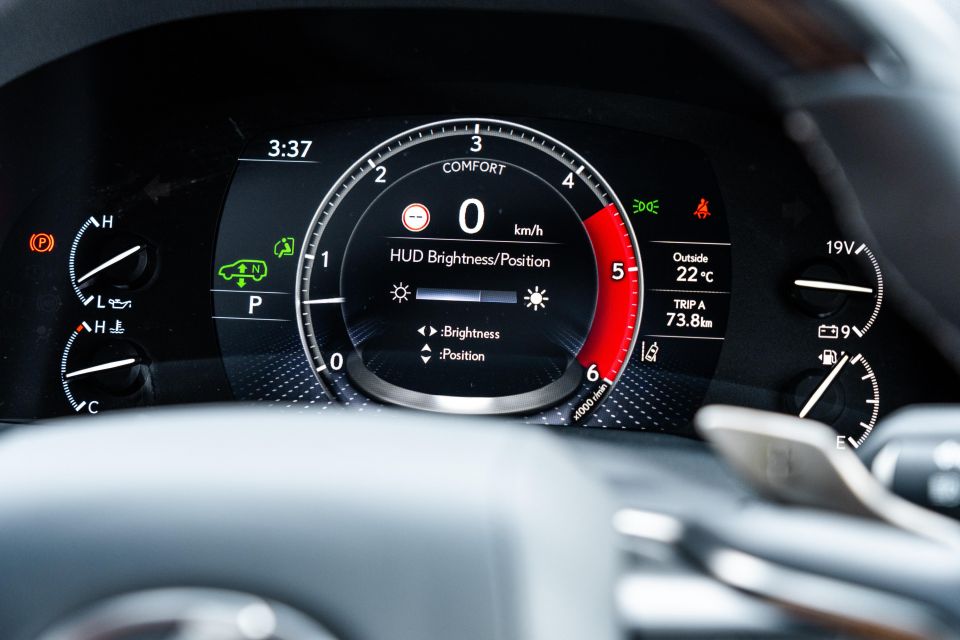
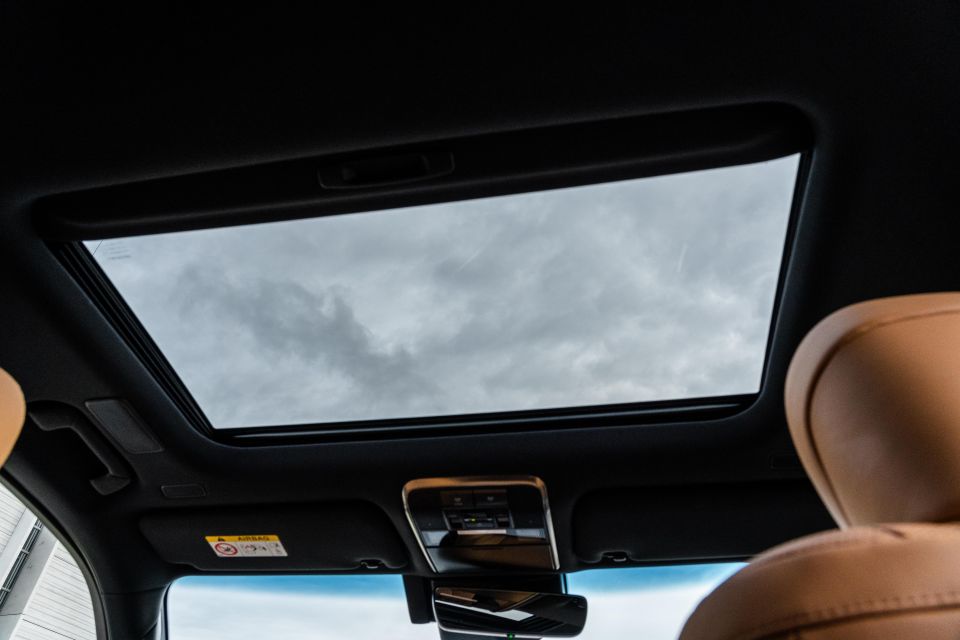
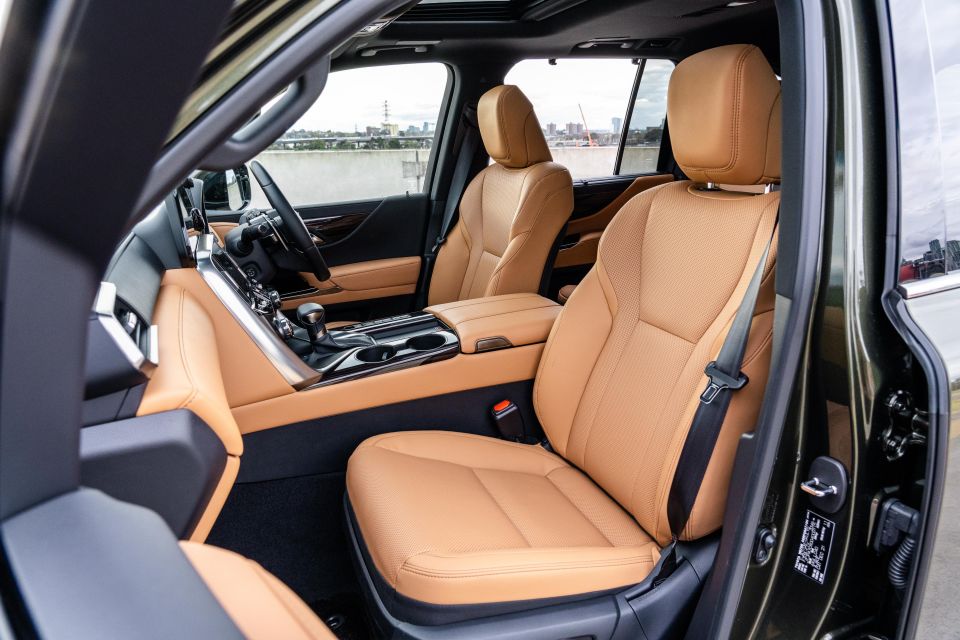
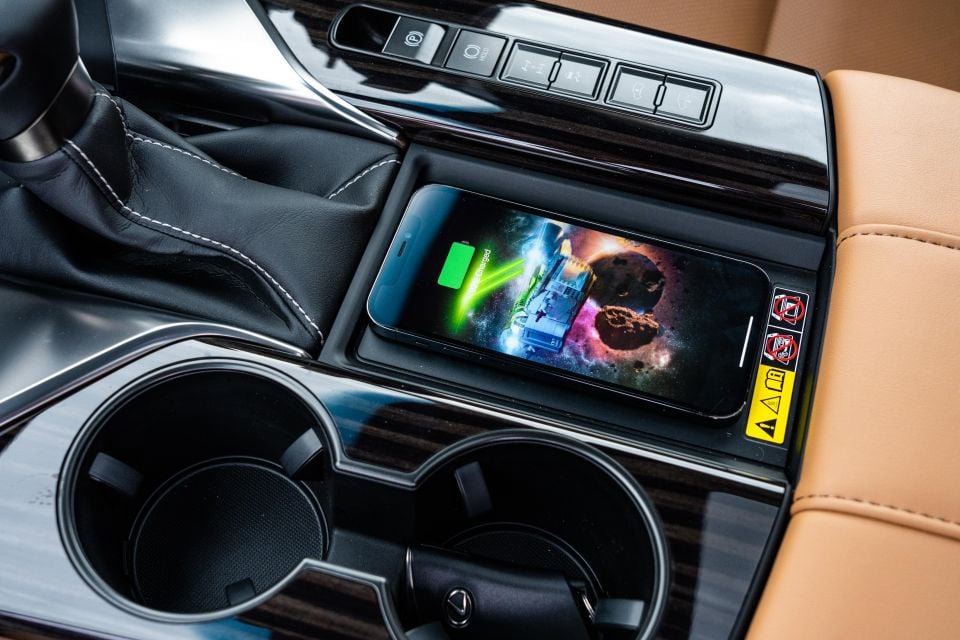
There’s a model-specific digital instrument cluster with great resolution, an analogue tachometer, and digital speedometer. For those who prefer a traditional look, there are manual gauges for oil and water temperature, battery status, and fuel tank level.
A large head-up display projects on the windscreen and shows you speed, revs, the current speed limit, and your lane-keeping aid prompts.
Lexus hasn’t always been great at cabin displays and user-friendliness. But I have fewer complaints around the new 12.3-inch touchscreen display, mounted high on the dash, which is miles easier to use than the frustrating old trackpad device.
A vertical taskbar on the right-hand side of the display shortcuts you to your main functions, and the loading times and graphics seem suitably up-to-date. One critique is that at times the design leaves a lot of empty screen real-estate on the left-hand side of the display.
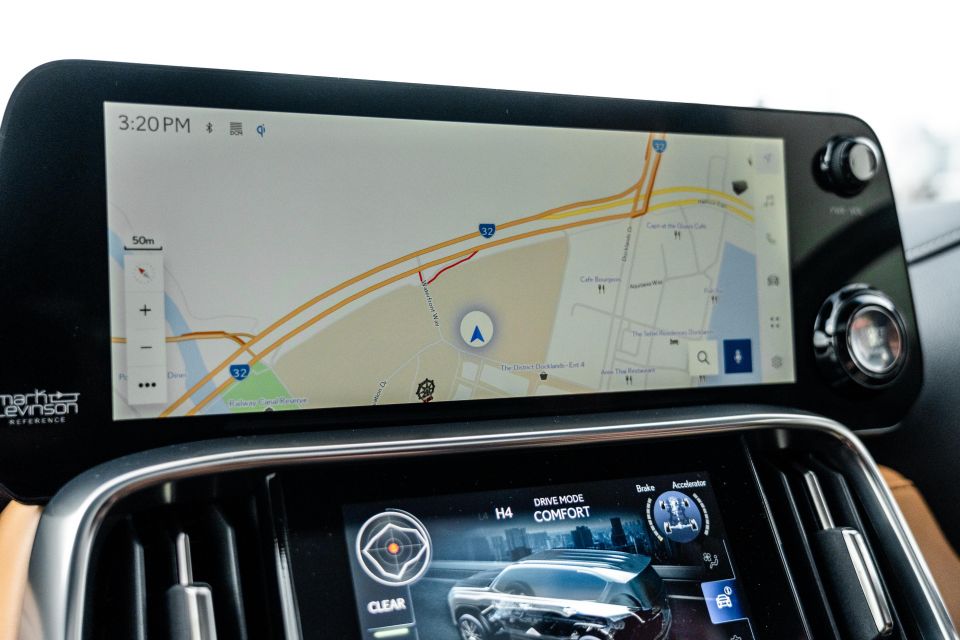
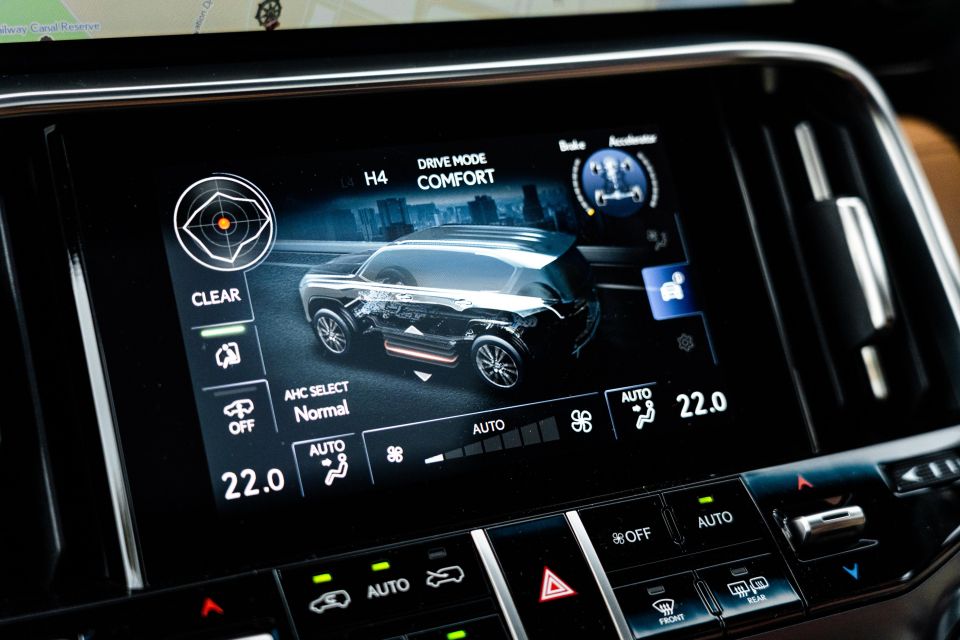
It all has a killer start sequence, with blue particles whooshing along a black surface.
Lexus has embraced voice-control functionality, with a command enabling you to do things like up the cabin temperate (say “Hey Lexus, I’m cold”), or open the moonroof (“Hey Lexus, open the sunroof”) – very much like Mercedes-Benz MBUX.
Over-the-air software updates will also possible due to the embedded Data Communication Module, which can upgrade system functionality over time.
There’s also an above-view camera mode that proves really helpful particularly off-road, or when negotiating tight car parks in such a big beast – as I found pulling into our inner-Melbourne office.
Below the big screen sits a smaller 7.0-inch one with fantastic graphics, which shows suspension height adjustments, front- and rear-seat climate menus, and even the brake/accelerator status and G-forces for some reason. Yes, you can turn if off.
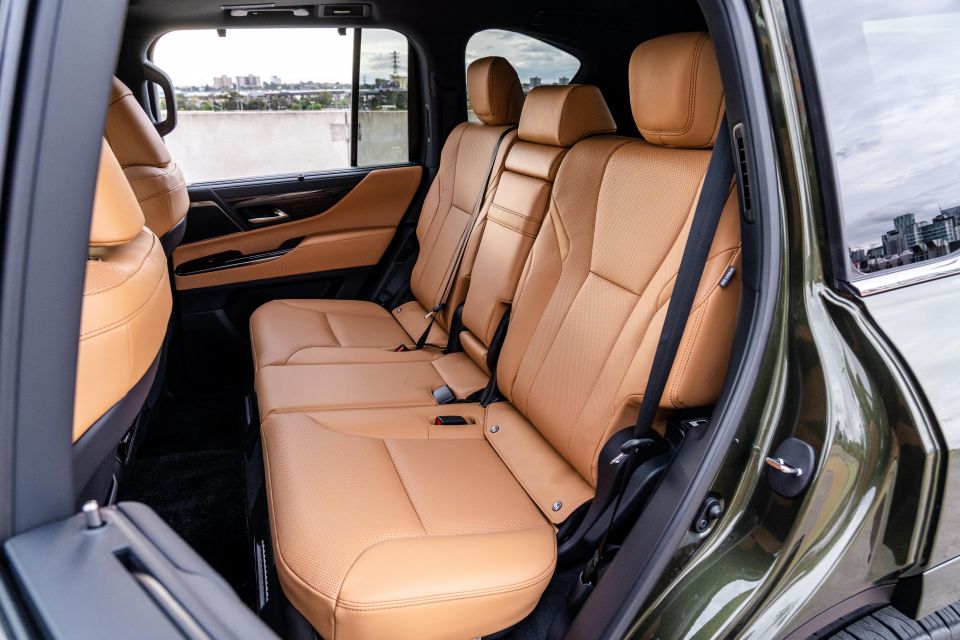
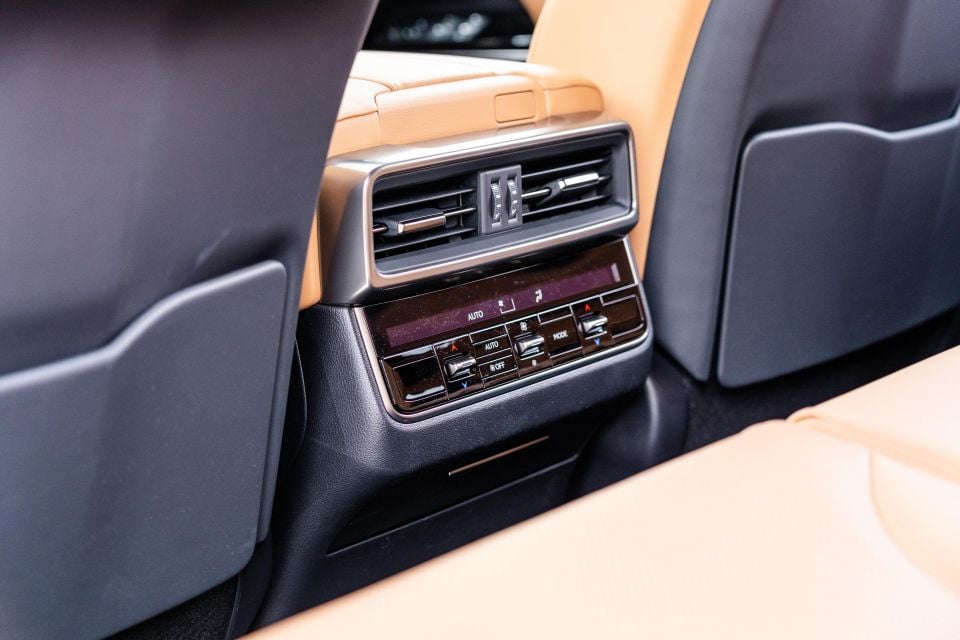
Below the air-conditioner controls are driving-related switches for the drive modes, high/low-range, off-road traction control, multi-terrain select 4×4 modes, downhill assist control and crawl control – paired to the screen to offer a range of read-outs.
Each LX is also fitted with a 25-speaker Mark Levinson audio system offering great clarity and definition, with speaker grilles finished in a distinctive pattern resembling “the veins of a leaf”. It made for great company on a long night-time commute, playing some of my more sonically complex Spotify playlists.
There’s plenty of storage scattered about of course, and a nifty side-opening centre console.
To the back seats. Foot room under the front seats is tight, but otherwise my 194cm body had heaps of space behind my own driving position, and the big windows (with pull-up blinds) really lighten the ambience back there.
You get a centre flip-down leather armrest with inbuilt cupholders, rear vents with individual temperature controls, and nice lighting. The seat backs also recline if you’re feeling tired.

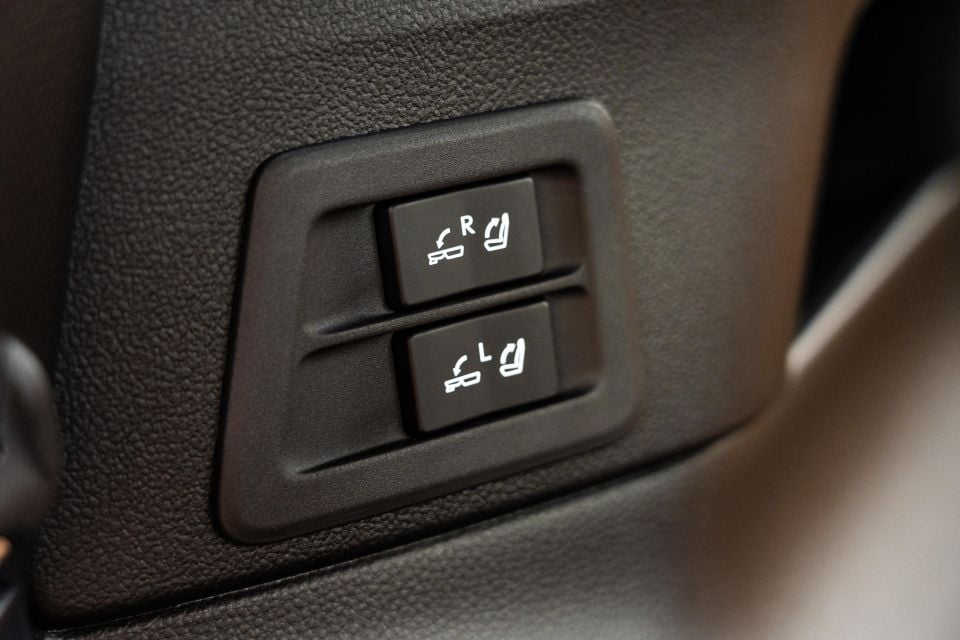
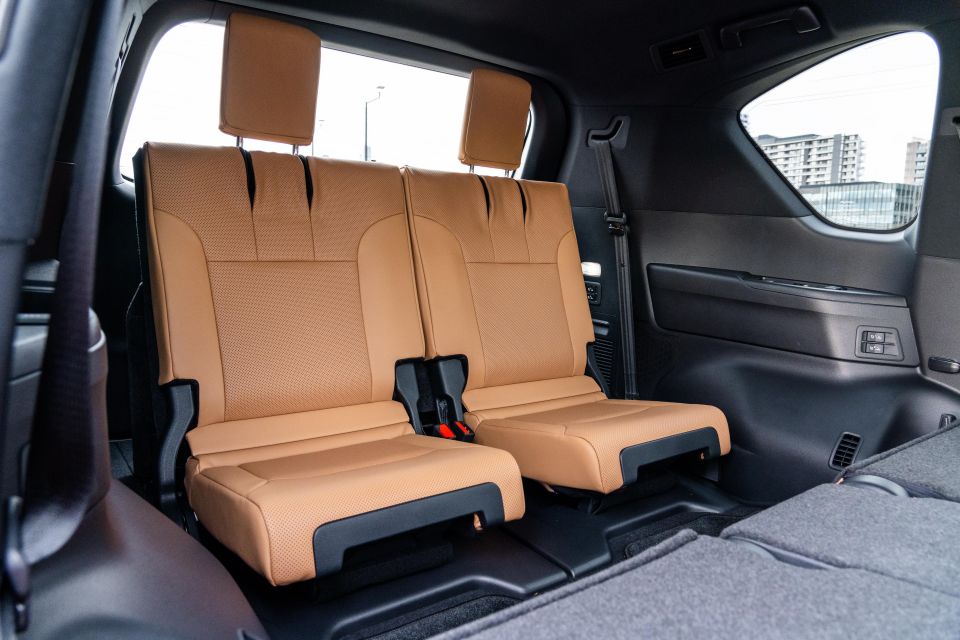
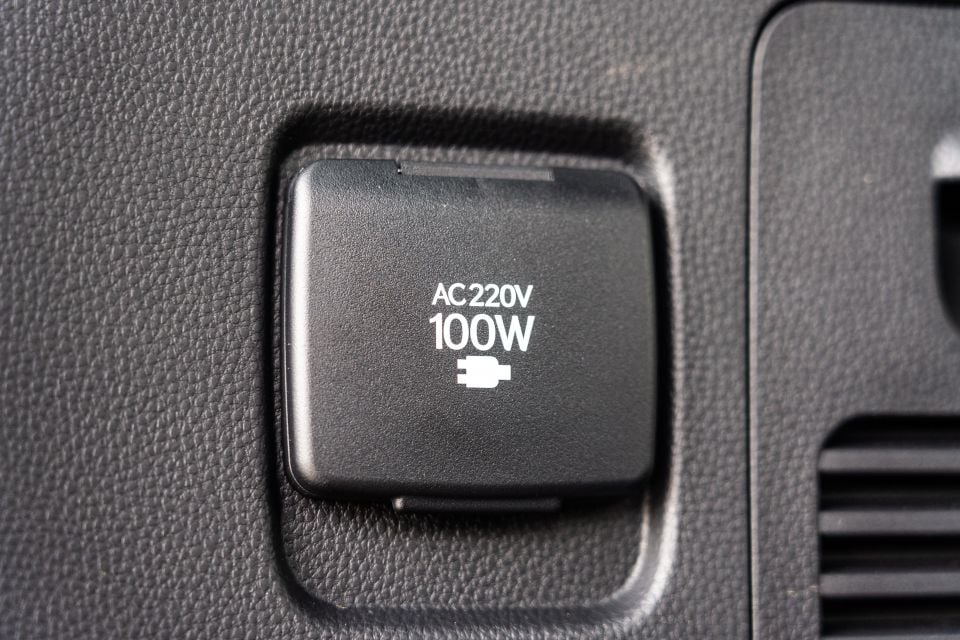
Unlike the LandCruiser Sahara ZX, there is a third seating row comprising two separate seats, which when not in use folds into the floor electrically – just push a button and the seats rise up and down, saving you any tiresome arm exercises.
Access to them from the kerbside comes from pulling a lever near the seat base, causing it to tilt and tumble. Getting in requires some gymnastics for adults (it’s really more kid-friendly) but there’s actually adult space once situated, tight headroom aside. There are also vents, overhead handles and USBs.
Approaching the powered tailgate at night is very theatrical on account of the beautiful full-width LED light bar.
Boot space with five seats in use and the third row folded down is 982L VDA, but with the sixth- and seventh seats in play there’s not much room for bags at all (174L). Certainly less than a typical people-mover or MPV.
The boot contains a 220V power outlet too.
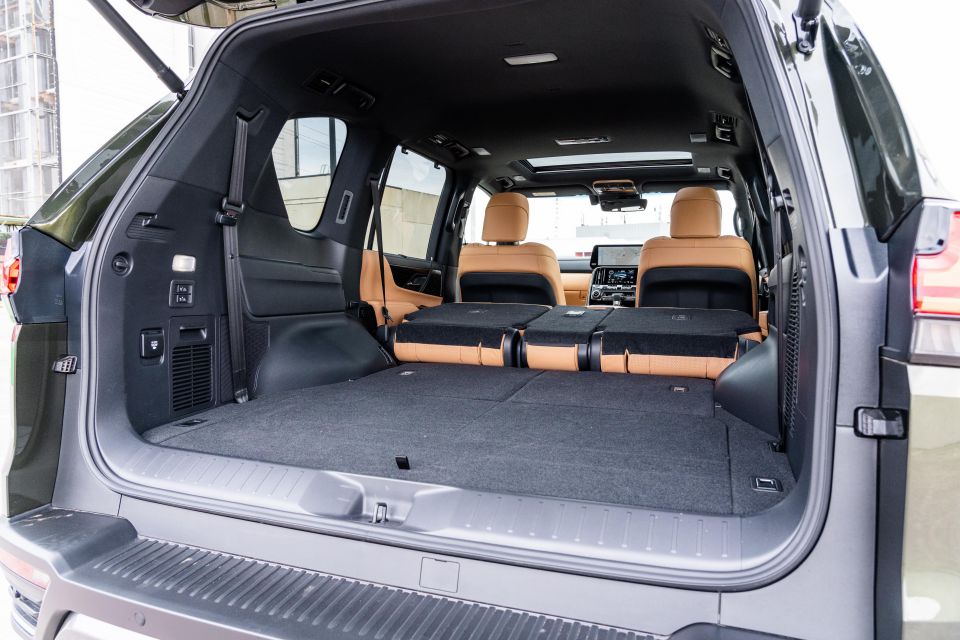
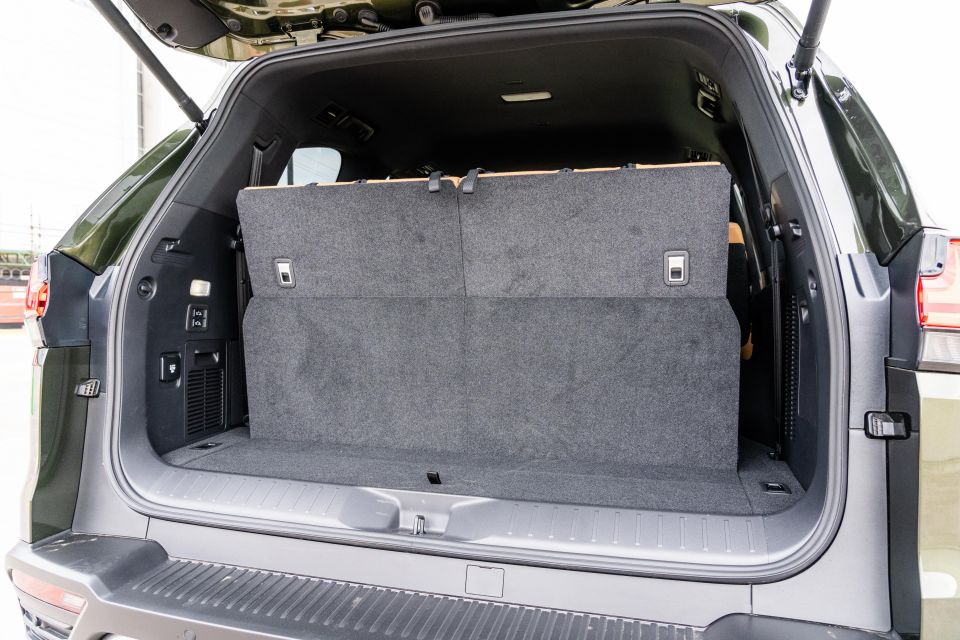
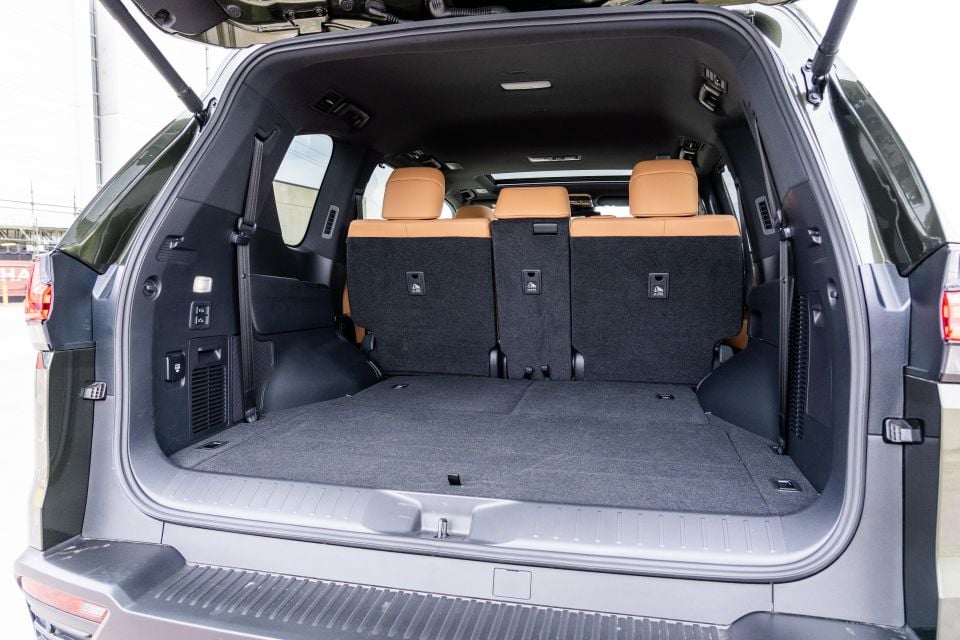
| Lexus LX500d | |
|---|---|
| Length | 5100mm |
| Width | 1990mm |
| Height | 1895mm |
| Wheelbase | 2850mm |
| Cargo space 5 seats | 982L (VDA) |
| Cargo space 7 seats | 174L (VDA) |

The LX500d model as tested here shares the LandCruiser’s 3.3-litre twin-turbo V6 diesel making 227kW (at 4000rpm) and 700Nm (between 1600 and 2600rpm).
Another option is the $3500 more expensive LX600 which uses a 3.5-litre twin-turbo V6 petrol with 305kW and 650Nm – up 35kW and 120Nm on the old 5.7-litre V8.
Both LX500d and LX600 powertrains use a full-time all-wheel-drive (AWD) system, with power channelled through a 10-speed automatic transmission. A transfer case means proper low-range, and the centre Torsen diff locks.
A trailer wiring harness with towing hitch is fitted to all grades, and braked towing capacity is 3.5 tonnes just like the LandCruiser 300.
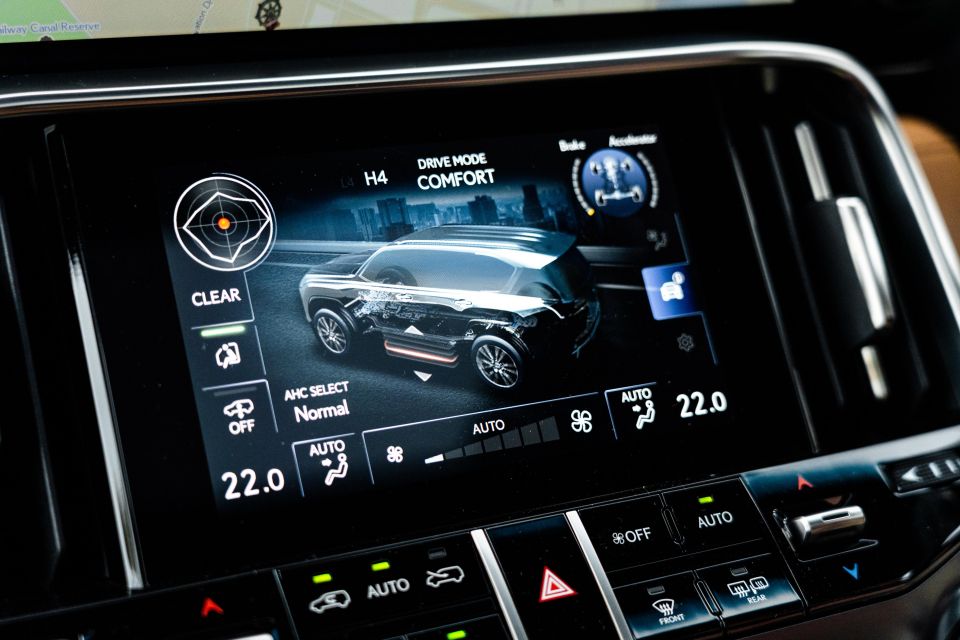
Claimed combined-cycle fuel economy for the LX500d diesel is 8.9 litres per 100km, however I averaged 9.9L/100km – still decent for such a big barge. My drive loop was biased towards highway miles, however.
One potential gripe is the fuel tank. All of the LX600 petrol models as well as the five-seat LX500d Sports Luxury and F Sport have 110L of fuel storage, but the base LX500d here only has an 80L tank.
If you’re someone who’s buying this beast as the ultimate grand tourer, just keep in mind the fact that the driving range– especially if towing – would take a hit.
The zero to 100km/h dash for the LX500d diesel is 8.0 seconds, which is exactly one-second slower than the LX600 petrol.
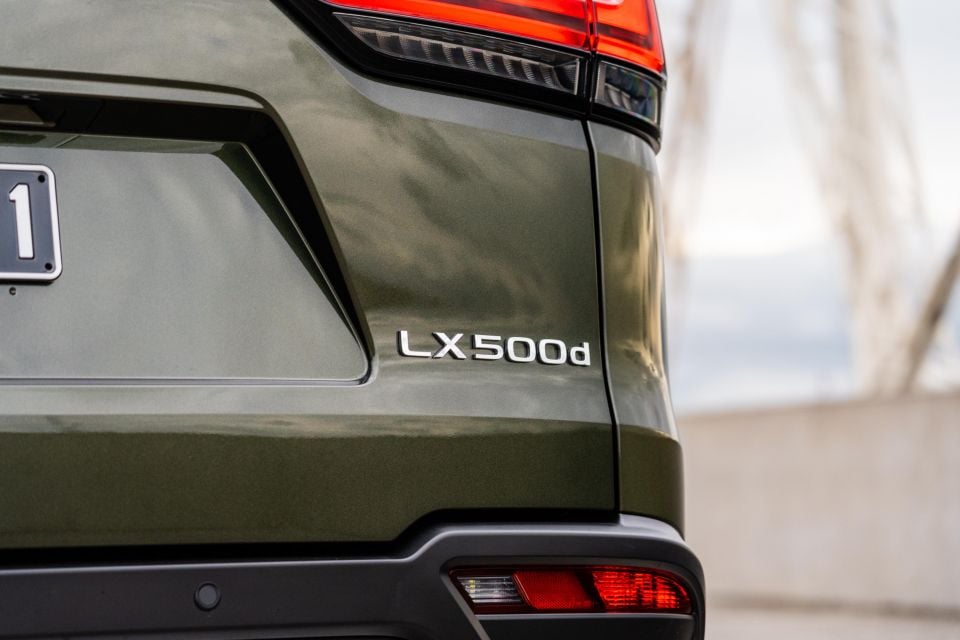
| Lexus LX500d | |
|---|---|
| Fuel type | Diesel |
| Displacement | 3.3-litre twin-turbo V6 |
| Power | 227kW at 4000rpm |
| Torque | 700Nm at 1600-2600rpm |
| 0-100km/h | 8.0 seconds |
| Transmission | 10-speed automatic |
| Fuel economy ADR | 8.9L/100km (CE got 9.9L/100km) |
| Fuel tank | 80L (other grades 110L) |
| Drive type | Permanent AWD with low-range |
| Towing capacity | 3500kg |
| Kerb weight | 2690kg |
| GVM | 3280kg |
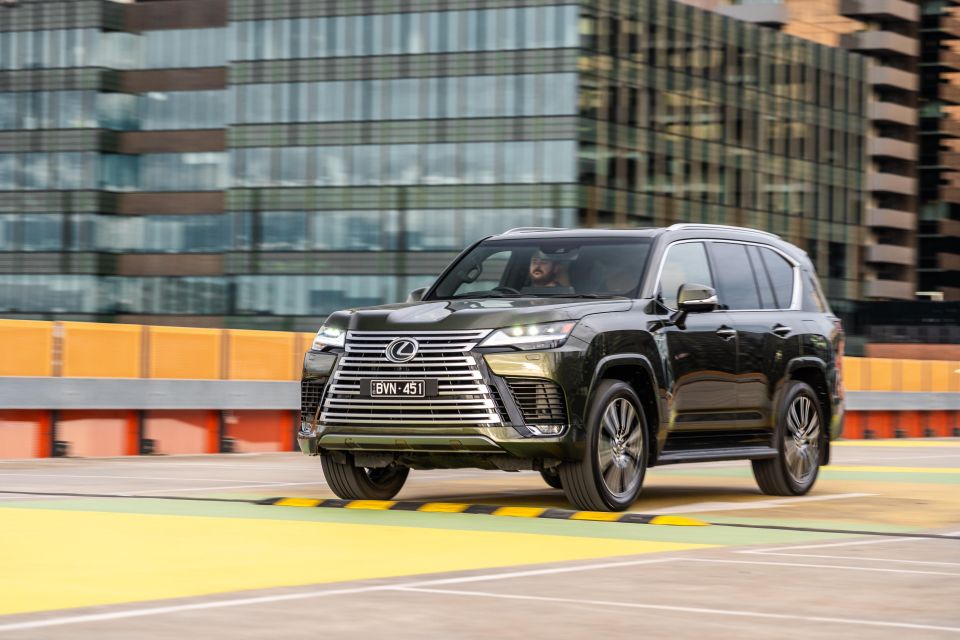
The experience of wafting down a highway in the LX500d is a little bit like take-off in an Airbus A380: you know things are happening but you’re almost entirely isolated from them.
Even with 22-inch wheels it dispatched both speed bumps and badly degraded country roads with similar ease, and the cabin noise levels at 110km/h were suitably muffled thanks to active sound control – like noise-cancelling headphones.
This is a big, heavy car with no sporting aspirations, but just try taking any German SUV (Mercedes G-Class aside) off the beaten path… Granted, the LX F Sport grade adds a rear Torsen LSD to control power allocation, but it can only do so much…
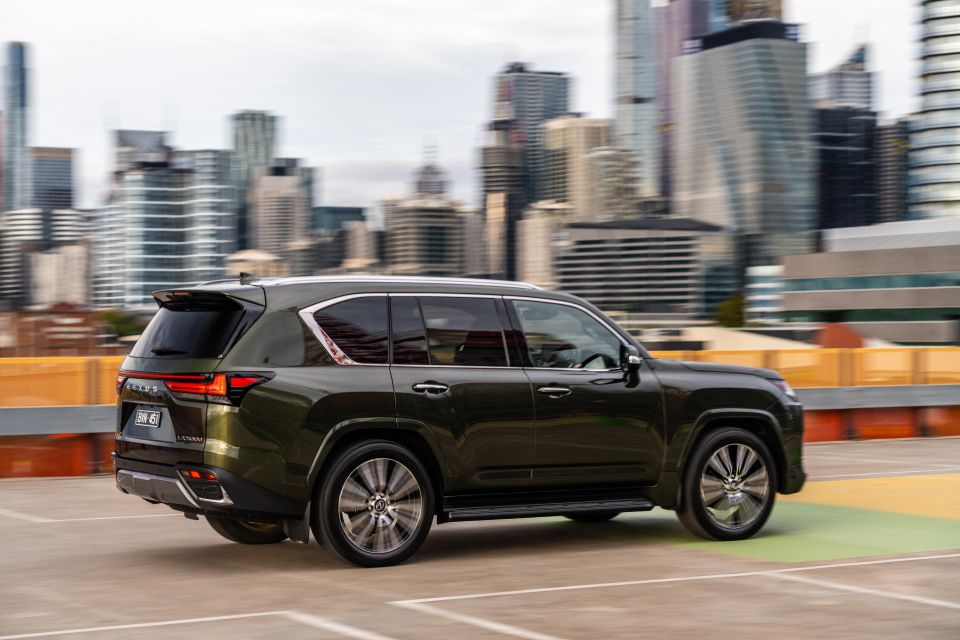
As we found in the LandCruiser 300, the new V6 diesel is an absolute belter, delivering a surge of power and a deep reservoir of torque, which frankly puts the old diesel V8 in the shade for my money. It’ll tow 3500kg, and I reckon you’d barely notice that big van or boat trailing behind.
It’s not the final word in refinement though, with a noticeable diesel grumble from outside at idle, but there’s a heap of interior sound-deadening to reduce that when you’re driving.
Some 10-speed transmissions feel fussy and indecisive, plagued by ratio options paralysis. But I had no such reservations around the Toyota/Lexus ‘box.
The suspension comprises adjustable damping, front double wishbones up front, and at the rear a four-linkage rigid axle, with both ends having stabiliser bars. There’s also four-wheel multi-height suspension, and to my surprise I could leave it in extra-tall mode beyond 4L speeds.
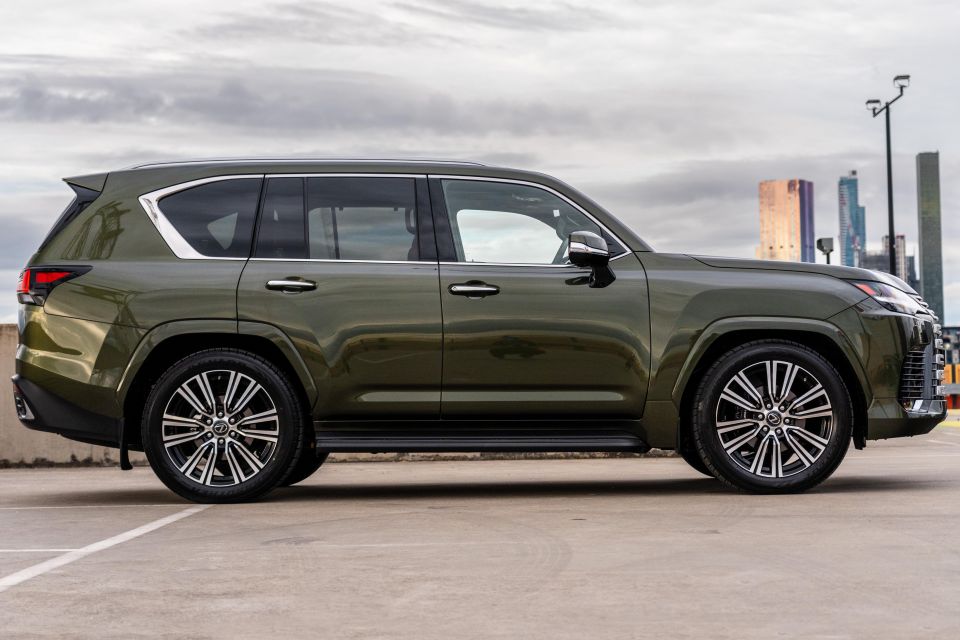
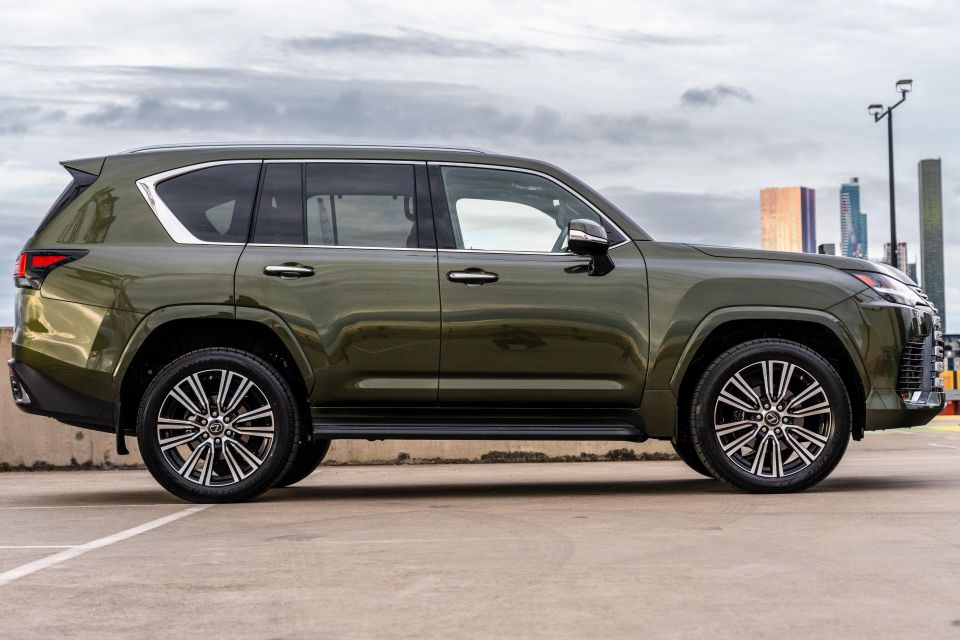
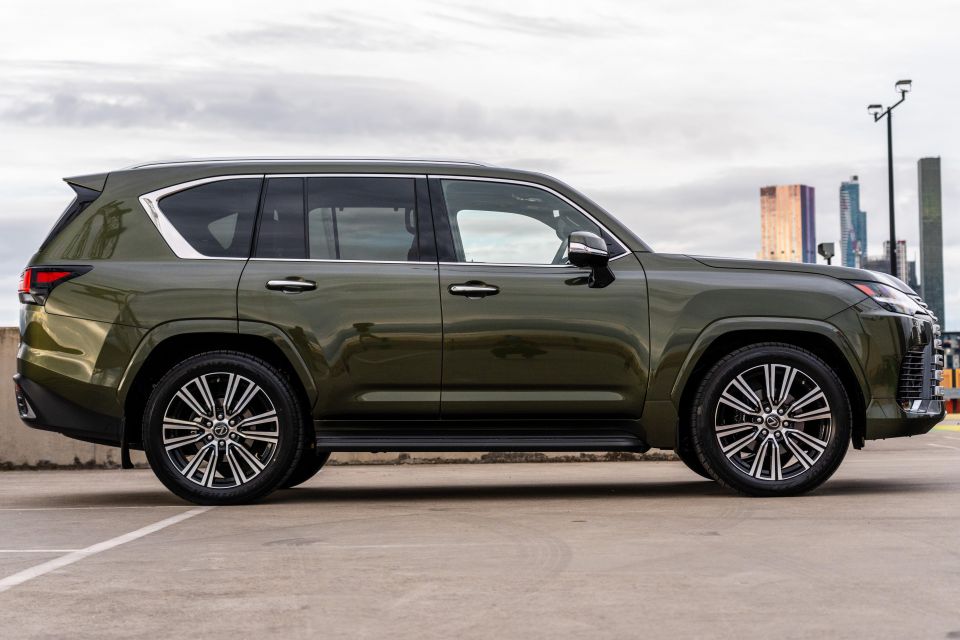
The height control and adaptive suspension systems use hydraulic pressure in each wheel’s shock absorber to control vehicle height and damping force to best suit the driving conditions or the driver preference.
For the height control system, oil is sent from the pump to the shock absorbers – which extend and compress to adjust vehicle height and spring strength. It’s a slow-ish system, but nevertheless undeniably great to watch and helpful for cabin access or rock-hopping at either extreme.
The LX’s suspension also features auto-levelling where a consistent vehicle height can be maintained, regardless of load conditions including number of occupants, level of luggage and towing.
Drive is delivered to the road through a permanent AWD system with a low-range transfer case that’s 25 per cent quicker than before, and there are multiple various terrain-specific modes including Dirt, Sand, Mud, Sand, Deep Snow and Rock.

Between these modes and the trick camera with an overhead ‘see through’ view, the LX does that Range Rover thing of holding your hand while you waft over rugged terrain.
Stopping power comes from huge 354mm x 32mm front ventilated rotors with four-piston calipers, and 335mm x 20mm single-piston caliper rear rotors. This thing weighs a whopping 2690kg, and has a 3280kg GVM, so you need some serious brakes.
There’s also a rack-assisted electric power steering system which enables a lane-centring function that goes beyond the LandCruiser’s setup.
| Lexus LX500d | Toyota LandCruiser Sahara ZX | |
|---|---|---|
| Running ground clearance | 205mm | 235mm |
| Approach angle | 22 degrees | 24 degrees |
| Departure angle | 22.8 degrees | 25 degrees |
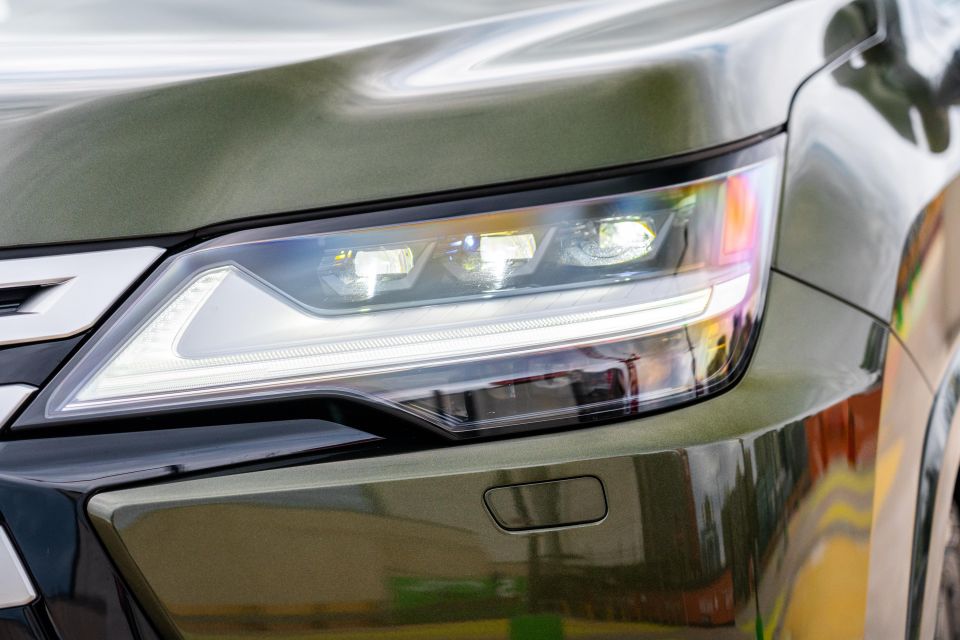


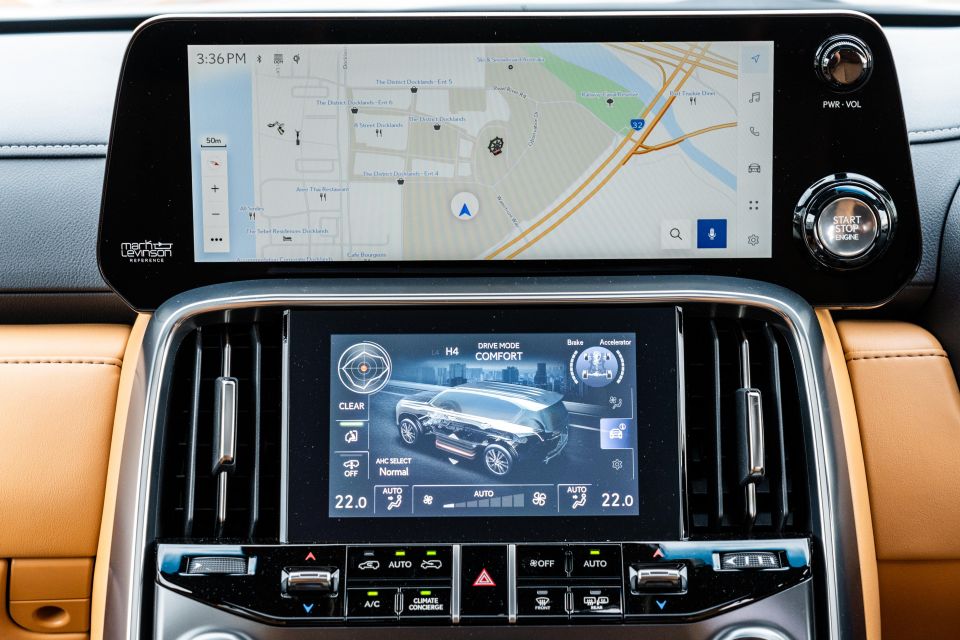
LX500d and LX600 highlights:
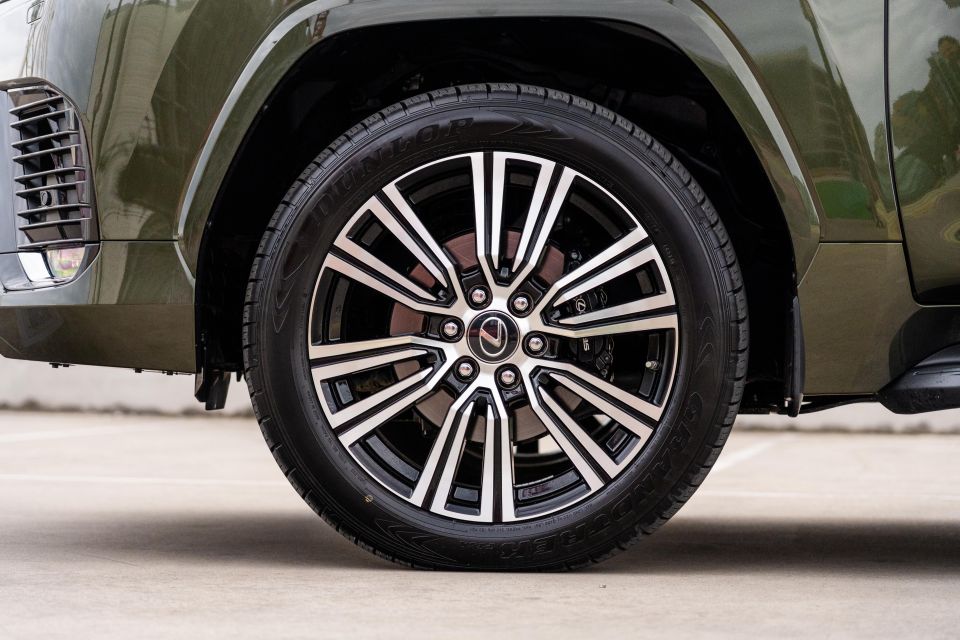
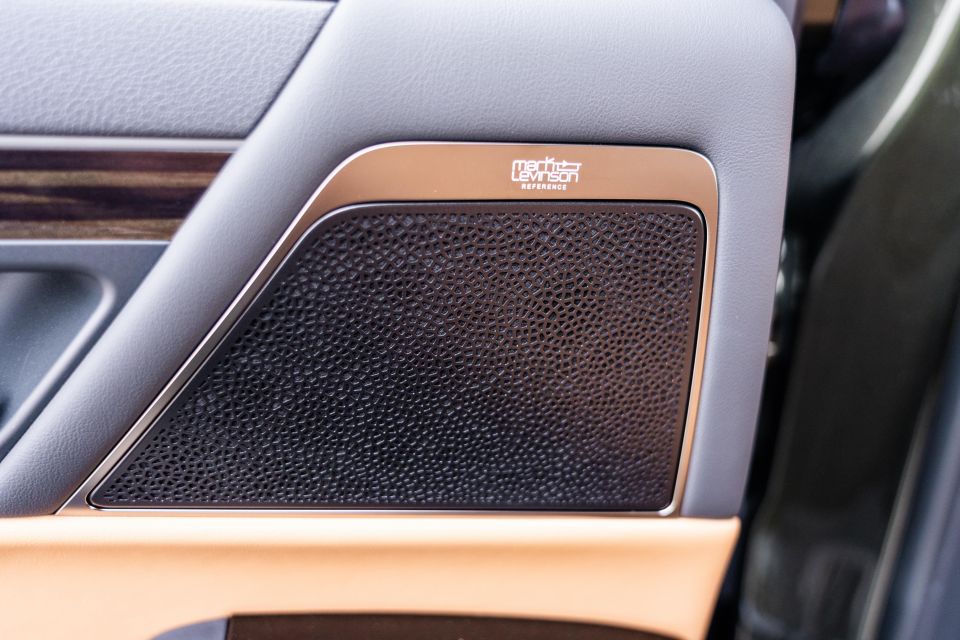
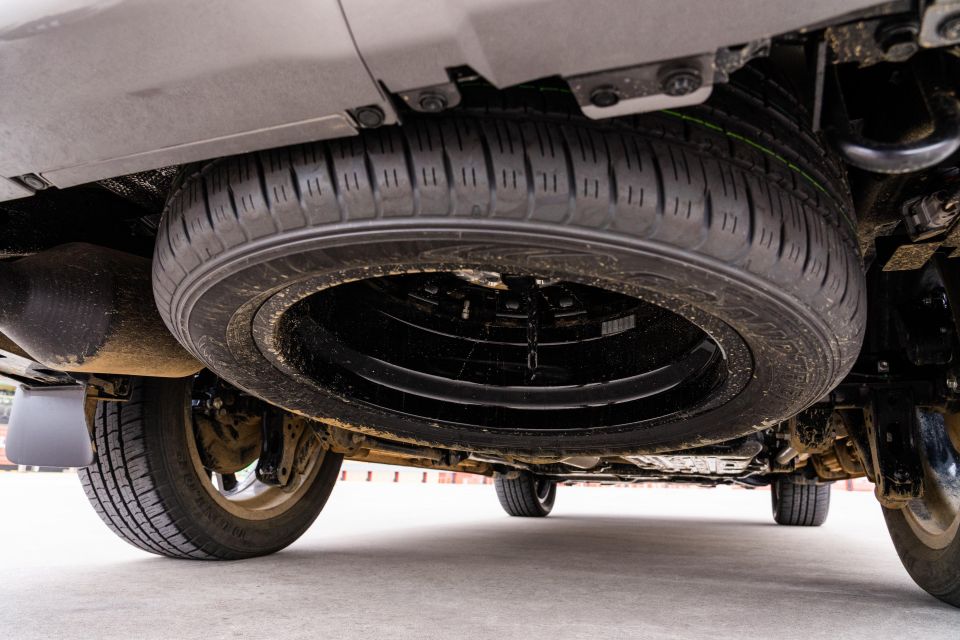
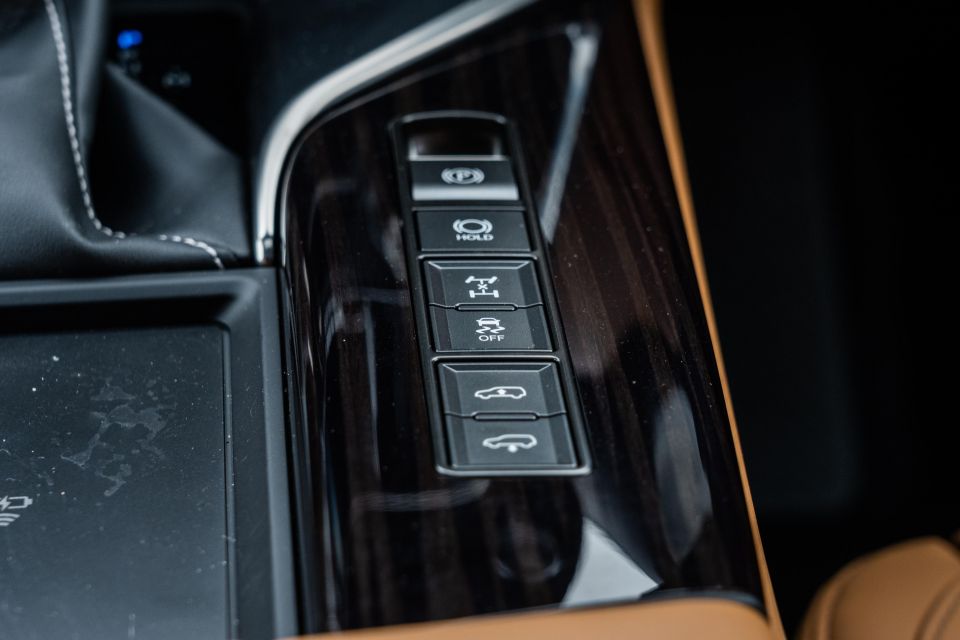
Over-the-air software updates are possible thanks to the vehicle’s embedded Data Communication Module, which can upgrade the system’s functionality over time.
Six exterior colours are available on the all-new LX, consisting of Sonic Quartz, Titanium, Liquid Metal, Onyx, Graphite Black and Khaki Metal – our car has the lattermost option.
For the full 2022 Lexus LX range breakdown, click here.
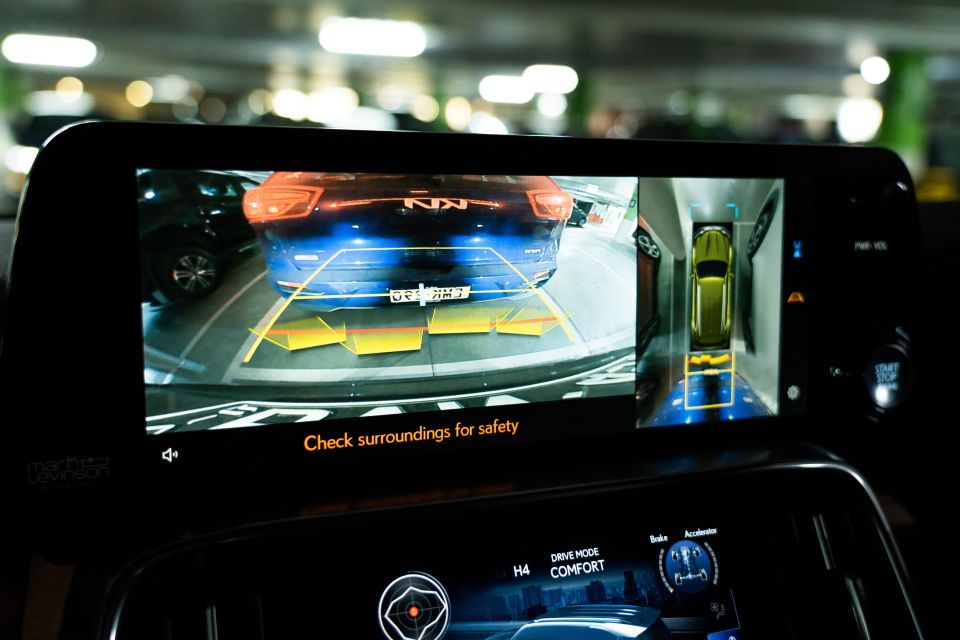
The Lexus LX hasn’t yet been crash tested by ANCAP or Euro NCAP, though the related Toyota LandCruiser 300 Series earned a five-star rating earlier in 2021.
Standard safety equipment includes:
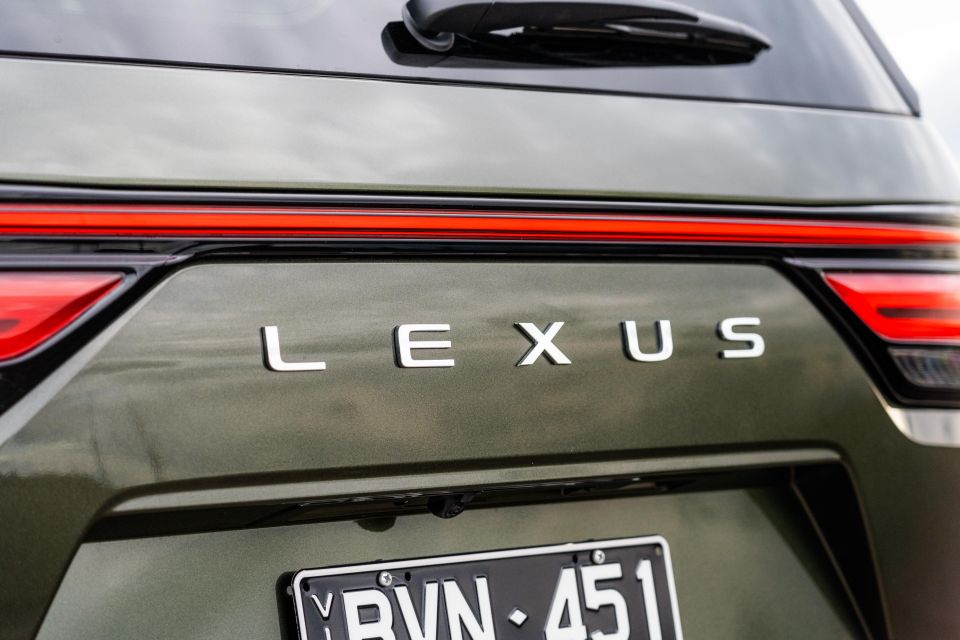
Owners get a five-year, unlimited-kilometre warranty, and also join Lexus’s Encore Platinum ownership program.
It comes with three years of capped-price servicing, costing $595 for each of the first six scheduled services with shorter-than-average intervals of six months/10,000km. At least Lexus does service pickups and drop-offs, and courtesy cars.
What does Encore Platinum get you? This story breaks it down in more detail.
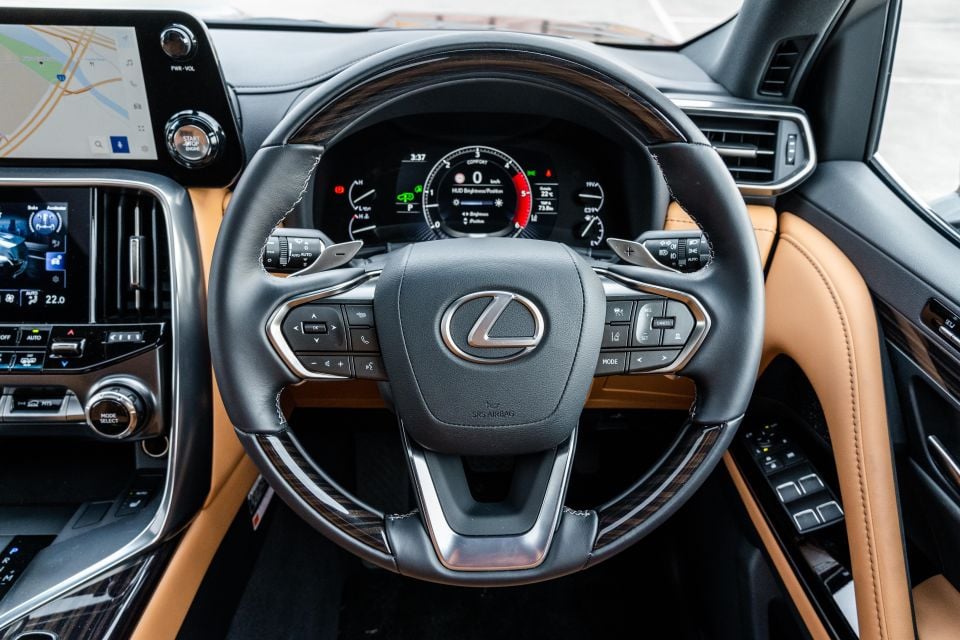
The Lexus on Demand component means an invitation to borrow another Lexus up to four times during a three-year membership, for up to eight days at a time: perhaps an LC Convertible for a winery weekend, a UX300e to experience EV driving, or an LS limo for a business trip.
Cars can be booked through an app for collection at Qantas valets in Sydney, Melbourne, Brisbane, Adelaide and Perth airports, or in Auckland and Queenstown in New Zealand. Members can also book a vehicle for collection at some Lexus dealerships.
The LX also has ‘Lexus Connected Services’, which uses a data control module in the vehicle in combination with the Lexus app. Users can lock and unlock the vehicle doors and boot remotely, turn the ignition on and off; and operate the hazard lights, headlights buzzer and horn etc.
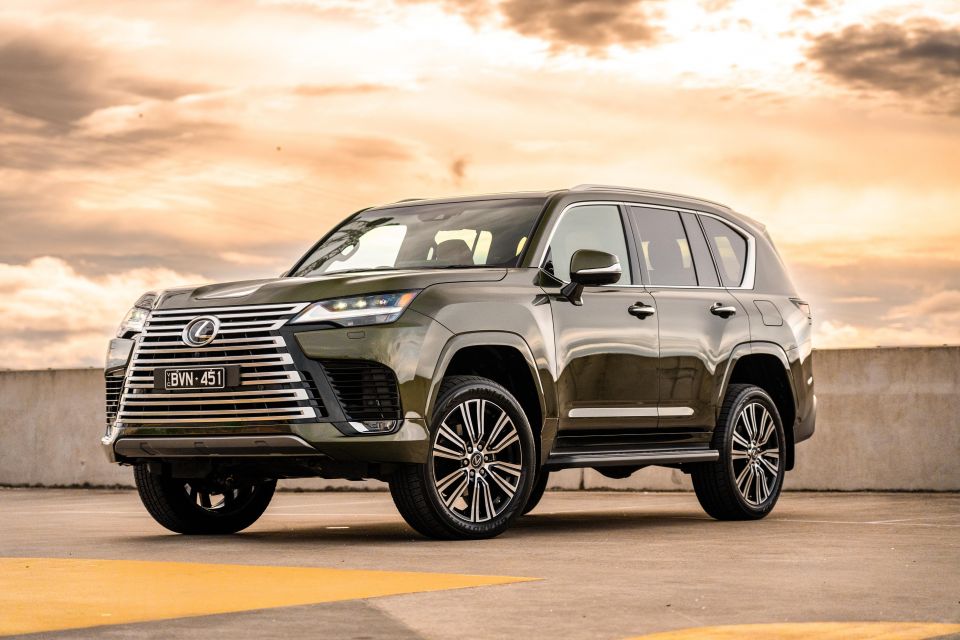
When a mere LandCruiser 300 isn’t enough, the Lexus LX now offers a more compelling package than ever. Yes it’s still ultimately a slightly glossier ‘Cruiser, but there’s more differentiation this time.
This Japanese Range Rover offers effortless on-road performance and hauling, some legit 4×4 cred, and a suitably lounge-like interior – with seven seats.
It’s a commanding flagship for the brand, and will no doubt broaden its appeal.
Keep an eye out for our review of the LX600 petrol, coming soon, and be sure to check out Paul’s walkaround video below.
Click the images for the full gallery
Take advantage of Australia's BIGGEST new car website to find a great deal on a Lexus LX.


William Stopford
3 Months Ago


Scott Collie
2 Months Ago


William Stopford
2 Months Ago
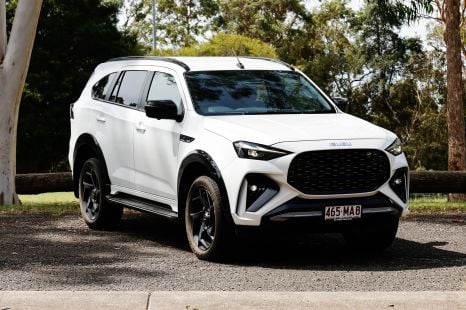

Matt Campbell
21 Days Ago
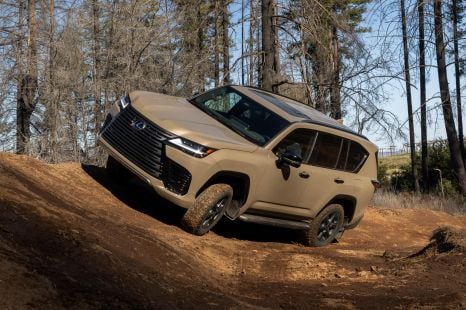

William Stopford
16 Days Ago
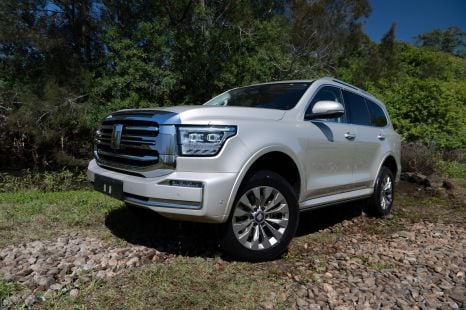

Damion Smy
16 Days Ago